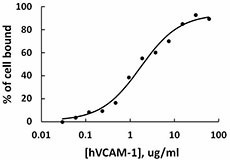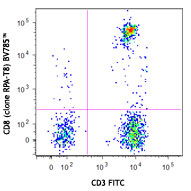- Regulatory Status
- RUO
- Other Names
- CD106, INCAM-100, Vascular cell adhesion molecule 1 (VCAM-1)
- Ave. Rating
- Submit a Review
- Product Citations
- publications

-

U937 cells are able to bind to immobilized human VCAM-1-Fc chimera in a dose dependent manner. The ED50 = 0.5 - 2.5 µg/mL. Over 80% of the cells were able to bind human VCAM-1 at a dose greater than 5 µg/mL (100 µL/well coated).
| Cat # | Size | Price | Quantity Check Availability | Save | ||
|---|---|---|---|---|---|---|
| 553704 | 25 µg | 118€ | ||||
| 553706 | 100 µg | 278€ | ||||
VCAM-1, vascular cell adhesion molecule 1, is a member of the immunoglobulin superfamily. It is expressed on both large and small blood vessels only after the endothelial cells are stimulated by cytokines, such as IL-4, TNF-α, and IL-1. Within the Ig superfamily, VCAM-1 belongs to a subfamily of cell surface molecules including ICAM-1, -2, and -3, and MAdCAM-1, that bind leukocyte integrin ligands. Members of this family are distinguished by the presence of four cysteine residues instead of the usual two in domains important for counter-receptor binding. Structurally, VCAM-1 exists in two alternatively spliced forms on endothelial cells, a major form comprised of seven Ig-like domains, and a minor form with six Ig-like domains. It has been further demonstrated that domains 1 and 4 of VCAM-1 are critical for binding to its counter-receptor VLA-4 (very late antigen 4, α4β1), while domains 1-3 are important for cell adhesion and costimulation of T cells. The interaction of VCAM-1 and VLA-4 appears to play a role in a number of developmental pathways and inflammatory functions. In addition, it was shown that by interacting with VLA-4, VCAM-1 recruits monocytic osteoclast progenitors and elevates local osteoclast activity. Antibodies against VCAM-1 and integrin α4 effectively inhibit bone metastasis progression and preserve bone structure. These findings establish VCAM-1 as a promising target for the prevention and inhibition of metastatic recurrence in bone.
Product DetailsProduct Details
- Source
- Human VCAM-1, amino acids (Phe25-Glu698) (Accession# NP_001069.1), was expressed in 293E cells with a human IgG1 Fc tag and a His tag at the C-terminus.
- Molecular Mass
- The 914 amino acid recombinant protein with a C-terminal human IgG1 Fc tag has a predicted molecular mass of approximately 101.4 kD. The protein migrates at approximately 130 kD by SDS-PAGE in DTT-reducing conditions and approximately 260 kD in non-reducing conditions. The predicted N-terminal amino acid is Phe.
- Purity
- >95%, as determined by Coomassie stained SDS-PAGE.
- Formulation
- 0.22 µm filtered protein solution is in PBS.
- Endotoxin Level
- Less than 0.01 ng per µg cytokine as determined by the LAL method.
- Concentration
-
25 µg and 100 µg sizes are lot-specific and bottled at the concentration indicated on the vial. To obtain lot-specific concentration and expiration, please enter the lot number in our Certificate of Analysis online tool.
Please note, new lots of the 100 µg size will be lot-specific and may differ from previous lots that had a fixed concentration. - Storage & Handling
- Unopened vial can be stored between 2°C and 8°C for up to 2 weeks, at -20°C for up to six months, or at -70°C or colder until the expiration date. For maximum results, quick spin vial prior to opening. The protein can be aliquoted and stored at -20°C or colder. Stock solutions can also be prepared at 50 - 100 µg/mL in appropriate sterile buffer, carrier protein such as 0.2 - 1% BSA or HSA can be added when preparing the stock solution. Aliquots can be stored between 2°C and 8°C for up to one week and stored at -20°C or colder for up to 3 months. Avoid repeated freeze/thaw cycles.
- Activity
- Immobilized human VCAM-1-Fc chimera is able to bind U937 cells (5x104/well, 1 h at room temperature) in a dose dependent manner. Over 80% of the cells were able to bind human VCAM-1 at a dose greater than 5.0 µg/mL.
- Application
-
Bioassay
- Application Notes
-
BioLegend carrier-free recombinant proteins provided in liquid format are shipped on blue-ice. Our comparison testing data indicates that when handled and stored as recommended, the liquid format has equal or better stability and shelf-life compared to commercially available lyophilized proteins after reconstitution. Our liquid proteins are verified in-house to maintain activity after shipping on blue ice and are backed by our 100% satisfaction guarantee. If you have any concerns, contact us at tech@biolegend.com.
Antigen Details
- Structure
- Homodimer
- Distribution
-
Vascular endothelial cells, smooth muscle cells, dendritic cells, macrophages.
- Function
- VCAM-1 is expressed on cytokine-stimulated vascular endothelial cells. It is alternatively spliced into two known RNA transcripts that encode different isoforms in humans.
- Interaction
- Lymphocytes, monocytes, eosinophils, and basophils.
- Ligand/Receptor
- VLA-4 (very late antigen-4 or α4β1) of the β1 subfamily of integrins, and integrin α4β7.
- Bioactivity
- Human VCAM-1 is able to bind U937 cells.
- Cell Type
- Embryonic Stem Cells, Mesenchymal Stem Cells
- Biology Area
- Cell Adhesion, Cell Biology, Immunology, Innate Immunity, Signal Transduction, Stem Cells
- Molecular Family
- Adhesion Molecules, CD Molecules
- Gene ID
- 7412 View all products for this Gene ID
- UniProt
- View information about VCAM-1 on UniProt.org
Related FAQs
- Why choose BioLegend recombinant proteins?
-
• Each lot of product is quality-tested for bioactivity as indicated on the data sheet.
• Greater than 95% Purity or higher, tested on every lot of product.
• 100% Satisfaction Guarantee for quality performance, stability, and consistency.
• Ready-to-use liquid format saves time and reduces challenges associated with reconstitution.
• Bulk and customization available. Contact us.
• Learn more about our Recombinant Proteins. - How does the activity of your recombinant proteins compare to competitors?
-
We quality control each and every lot of recombinant protein. Not only do we check its bioactivity, but we also compare it against other commercially available recombinant proteins. We make sure each recombinant protein’s activity is at least as good as or better than the competition’s. In order to provide you with the best possible product, we ensure that our testing process is rigorous and thorough. If you’re curious and eager to make the switch to BioLegend recombinants, contact your sales representative today!
- What is the specific activity or ED50 of my recombinant protein?
-
The specific activity range of the protein is indicated on the product datasheets. Because the exact activity values on a per unit basis can largely fluctuate depending on a number of factors, including the nature of the assay, cell density, age of cells/passage number, culture media used, and end user technique, the specific activity is best defined as a range and we guarantee the specific activity of all our lots will be within the range indicated on the datasheet. Please note this only applies to recombinants labeled for use in bioassays. ELISA standard recombinant proteins are not recommended for bioassay usage as they are not tested for these applications.
- Have your recombinants been tested for stability?
-
Our testing shows that the recombinant proteins are able to withstand room temperature for a week without losing activity. In addition the recombinant proteins were also found to withstand four cycles of freeze and thaw without losing activity.
- Does specific activity of a recombinant protein vary between lots?
-
Specific activity will vary for each lot and for the type of experiment that is done to validate it, but all passed lots will have activity within the established ED50 range for the product and we guarantee that our products will have lot-to-lot consistency. Please conduct an experiment-specific validation to find the optimal ED50 for your system.
- How do you convert activity as an ED50 in ng/ml to a specific activity in Units/mg?
-
Use formula Specific activity (Units/mg) = 10^6/ ED50 (ng/mL)
 Login / Register
Login / Register 














Follow Us